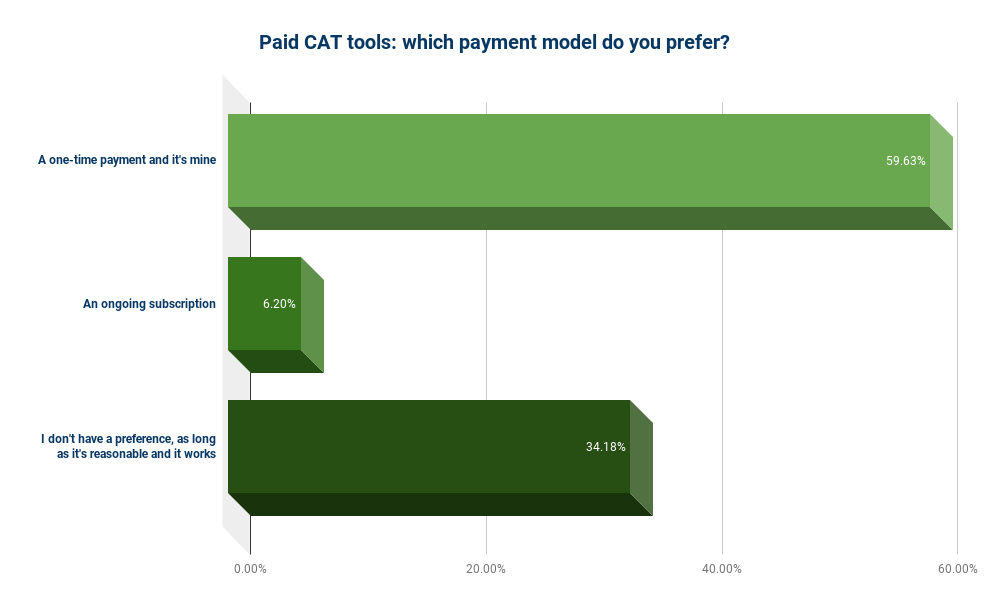Translator recommendations
Just to make sure the reader of this report would not be steered wrong about which CAT tools come most recommended, translators were asked which tool they would recommend to someone who is looking for their first CAT tool. The top ten here are the same as the top ten favorite CAT tools, as you may have guessed.

One of the hurdles many CAT tools have yet to cross is that of accessibility. For example, according to this article by Iman Refaat, many of the most frequently-used or popular CAT tools have limited or no compatibility with screen readers. This represents a problem not only with regards to a translator’s productivity and job opportunities, but an issue for the individual as a buyer/consumer. A visually-impaired consumer, when paying for a CAT tool, may be purchasing the product at the same price as everyone else but is paying for only partial usability, greatly reducing their potential return on investment. And if we focus just on visual impairment, it may be helpful to know that close to 13% of translators consider themselves seriously visually impaired.
Squeaky wheels sometimes get the grease, however, and thanks to Iman’s advocacy on behalf of the visually-impaired translator, she was able to report back in late 2022 that she had been contacted by the folks at both Memsource and memoQ, who were interested in incorporating feedback which would help improve the accessibility of their software (see this post in the ProZ.com Facebook group).
Investments in learning your CAT tool
The only people who made absolutely no investment in learning a CAT tool were a small percentage of the small group of translators who do not use a CAT tool but who have tried one in the past.
“Investment” here refers mostly to time, though some do invest in paid courses to learn one or more CAT tools. Everyone else put some time and effort in. And “effort” is relative: the two most common ways of learning a CAT tool are “Mostly trial and error” and “Read the manual”. So, as you can see, nothing fancy. Basic CAT tool training for the tool you are using is usually available, not time-consuming, and most often free nowadays. And for some CAT tools, active support forums and communities have grown out of the needs of their user base and the enthusiasm of some of the more proficient users for helping others to get what they are getting out of the software. If you take the perspective of the CAT tool as something to help you be more efficient and consistent in your work, it only makes sense to put in a certain amount of time and effort to not just learn how to use it, but to become fully proficient in it (thereby further increasing your efficiency, and your return on investment in the tool). And we’re not talking 10,000 hours here-- spend that on the actual translation. The majority of translators have spent fewer than 30 hours learning or getting trained in their CAT tool, and nearly 48% have spent fewer than 10 hours.

Productivity over time
How much does a CAT tool increase your productivity? Translators report an average increase in efficiency of 72%. In reporting this, translators were asked to base their productivity increase on an average project for them, in their main area of expertise (i.e. you wouldn’t expect the same level of productivity with some kinds of jobs, and especially not for jobs where you are less experienced in the subject matter). However, it is worth noting that 60% of translators say that the usefulness of their CAT tool does not decrease if they are translating outside their area of expertise (19% could not say for sure).




General preferences
A couple of newer trends in the delivery methods of a CAT tool struggle to gain ground among CAT tool users. Software in general is increasingly web-based, and paid software is also increasingly via a subscription model. Most translators still prefer a desktop or locally-installed version of a CAT tool, and most also prefer the payment model where you pay once and that version is yours, potentially with some upgrades included in the package.


Non-CAT tool users: What would change your mind?
When translators who do not use a CAT tool were asked what might cause them to reconsider using a CAT tool, price was the top factor. For some of the better-known and more popular tools, pricing indeed is not trivial for the freelancer just getting started out. Note, however, that some CAT tools nowadays are free to use, or have free-to-use versions, so if price is limiting your decision, you may do well by starting there.



Up next: The next wave, already upon us: Artificial intelligence
This post comes from CAT tools 2023: an industry report. ProZ.com industry reports can be found at https://www.proz.com/industry-report/ . ProZ.com paying members receive immediate, full access to the information available in industry reports, which are about and for freelance language professionals.




